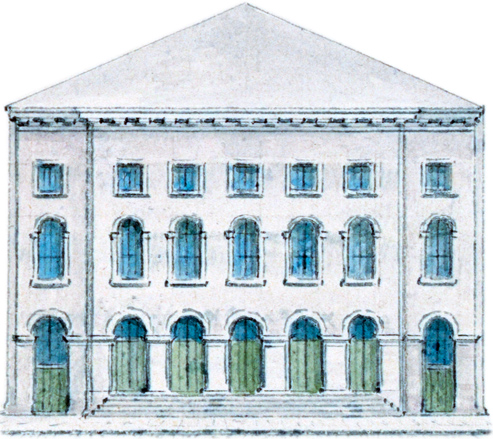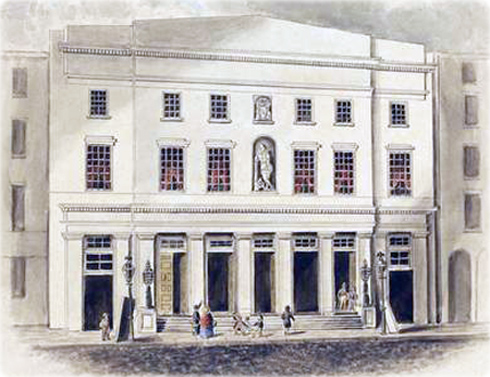
Second Park Theatre
This second Park Theatre was located at 21–25 Park Row, New York City. It was built in 1821, after the first Park Theatre was destroyed by fire in 1820 on the same site. The second Park Theatre and was also destroyed by fire in 1848. The Theatre is considered the birthplace of opera in New York.
 The
first Park Theatre
opened in 1798 as the "New Theatre". It was a magnificent neoclassical building,
acquired by John Jacob Astor and John K. Beekman on April 21, 1806. Local
newspapers began to call it "Park Theatre" in 1799, but the name was not officially
used. Outside New York City it was usually called the "New-York Theatre".
The first Park Theatre was destroyed by fire on May 25, 1820.
The
first Park Theatre
opened in 1798 as the "New Theatre". It was a magnificent neoclassical building,
acquired by John Jacob Astor and John K. Beekman on April 21, 1806. Local
newspapers began to call it "Park Theatre" in 1799, but the name was not officially
used. Outside New York City it was usually called the "New-York Theatre".
The first Park Theatre was destroyed by fire on May 25, 1820.
The managers of the Theatre immediately engaged the Anthony-Street Theatre (now Worth Street) and, on the 29th of May, four days after the calamity, the Stephen Price's theater company performed there. English actor Edmund Kean (1820) appeared for the first time in New York City, as Richard III, at the Anthony-Street Theatre, on 29 November 1820.
The owners John Jacob Astor and John K. Beekman began to rebuild the theater in January, 1821, but with a much simpler façade. This time, the new Park Theatre was designed, constructed and decorated by Americans. The architect and scene painter Hugh Reinagle (1788-1834) from Philadelphia, finished the designs and supervised the construction. He studied with John Joseph Holland (1776-1820) and was his assistant in the first Park Theatre, from 1811 to 1820. Reinagle also designed the Masonic Hall and was one of the founders of the National Academy of Design in 1825. John Evers, Jr. (1797–1884), another former assistant Holland helped Reinagle. Berwick directed the mason work. The stage and machinery was executed under the direction of George Concklin.
On May 12, 1821, Stephen Price and Edmund Simpson signed a lease on the Second Park Theatre for seven years. The new theater was completed by August. The original façade survived the fire in 1820 and was partially used in the reconstruction of the new Park Theatre, without the six Greek columns. A statue of Shakespeare was later installed in the central niche, converted from a window, on the second floor. Another sculpture was installed in a niche on the third floor.
On September 1, 1821, Saturday, the second Park Theatre officially opened as the "New Theatre" (the same name was used in the opening of the first Park Theatre in 1798), but called by the press "Park Theatre". It opened with the "Prize Address" written by Charles Sprague of Boston, after which it was presented the comedy Wives as they Were and Maid as the Are. It was followed by Therese, or The Orphan of Geneva.
The theater accommodated about 2,500 persons. According to the description of the New-York Evening Post (September 1, 1821), the new Park Theatre was 80 feet fronting the Park, 55 feet in height to the top of the cornice and 165 feet deep. Adjoining the rear of the house, on Theatre Alley, was a wing containing the green room, dressing rooms and other rooms connected to the Theatre. The roof was covered with zinc and the front of the building was covered by an oil cement invented by Reinagle and Berwick, in imitation of brown stone.
The vestibule or ticket lobby was 9 feet wide and 47.5 feet long. From this, spectators entered the check doors to the corridor or box lobby, through a double colonnade of 14 Ionic columns. The stairs to the second, third and fourth tier of boxes, led from each end of this colonnade, were seven feet wide, with mahogany rail and banisters throughout. The lobby at the narrowest part was 147 feet wide. The coffee room was on the second floor and fronted the Park Row. It was 50 ft in length, 16 ft wide and 17 ft in height, with large arched windows. The punch room was of similar dimensions, on the third story.
The form of the auditorium was that of a lyre, measuring at the stage boxes 52 ½ ft. The stage, at the drop curtain, was 38 ft wide and 70 ft deep from the front, and 40 ft to the ceiling. In each of the circles there were 14 boxes, supported by 15 small columns, 6 ft 6 inches in height. In the first tier, they were of burnished gold, the upper pillars were bronzed with gold, caps and bases. These columns receded 16 inched from the front, preventing the sight being obstructed. The decorations on the box fronts were in the Greek style, without division. Panels on the second tier were painted with figures representing boys with wreaths of flowers, supporting medallions of dramatic poets. The other tiers were also beautifully decorated. The ceiling was a flat surface painted in imitation of a dome opened to the sky, enriched with Greek elements. The proscenium was composed of four Doric columns 21 ½ ft high, painted in imitation of yellow marble, with white marble caps. The auditorium was lit with three chandeliers with 35 lamps, with those in the front of the stage and the side lights totaled 203 lamps.
Around 1822 to 1827, English George Gillingham (before 1768-1827) conducted the music in the Park Theatre.
In September, 1828, Park Theatre was leased to Edmund Simpson for seven years. Permission to erect a portico in front of the Park Theatre over the sidewalk, not exceeding five feet, was finally granted in July 28, 1828, to Simpson, after being rejected twice before in 1795 and in 1821. Park Theatre was totally remodeled from 1829 to 1834. Simpson remained the manager until he died on July 31, 1848, then the theater was leased to Thomas S. Hamblin.
On November 29, 1825, Spanish tenor Manuel García and his company began their performances of Italian opera at Park Theatre, which included The Barber of Seville (November 29), Otello (February 7, 1826), Il turco in Italia (March 14, 1826), Don Giovanni (May 23, 1826) and La Cenerentola (June 27, 1827).
In 1826, the interior of the theatre was repainted and ornamented, by Reinagle, Evers, T. Remable, Serra, and a new drop curtain painted by J. H. Wilkins. Gas lighting was tried in 1821 and added after 1827, but oil lighting was still in use in 1844.
In April 1830, the Italian opera L’ape musicale, by Lorenzo da Ponte (a professor of Italian at Columbia College), was performed at Park Theatre by a company almost entirely formed by Italian singers. Charles Kemble (1775-1854)'s first appearance in the United States was at this theater as Hamlet, on September 17, 1832. On February 14, 1842, Charles Dickens was lavishly honored at the Park Theatre. The event was called the the Boz Ball ("Boz" was his family nickname). John Jacob Astor, one of the owners of the Park Theatre, died on March 29, 1848.
On the evening of December 16, 1848, Saturday, a fire started about a quarter past six o'clock, an hour before the time appointed for the performances to take place. Smoke was seen to issue from the rear part of the Theatre, which butted on Theatre Alley. The alarm was given immediately but soon the whole building was enveloped in fire. A crowd of people rushed to the scene in a state of commotion. In one hour and three-quarters from the time the fire was discovered, the flames were subdued. The entire interior of the Theater was burned, but the exterior brick walls remained standing.
The fire originated by one of the young ladies of the ballet, while looking at some bills hanging near the prompter's box, pushing several of them against one of the gas lamps, when they took fire, which communicated to the adjoining scenery. She then ran and before any one else could reach the spot, the scenery was in flames.
This time, the Theatre was not rebuilt. The cornerstone of the first Park Building was removed from the site and preserved at "Windust's" after the second Park Theatre was burned. The ruins of the Park Theatre were demolished in June 1850. A five-story commercial building was erected on the site.
In 1863, a theater named Park Theatre opened in Brooklyn and was destroyed by fire in 1908. The "New Park Theatre" opened in 1874 at 932 Broadway and 22nd Street. It burned down in 1882. From 1911 to 1923, the old Majestic Theatre at Columbus Circle, Manhattan, was also called Park Theatre.
By Jonildo Bacelar, Geographic Guide editor, March 2025.
Park Theatre after renovation by 1830, drawn for the New York Mirror.
|
Copyright © Geographic Guide - Old NYC. 19th Century Historic Buildings. |

The Park Theatre in the late 1840s (burned in 1848). The illustration is not accurate. It is unlikely that the top of the façade ever had such a slope on each side. Source: Museum of the City of New York.
The old Park Theatre in the 1820s, before renovation by 1830 (Wilson, 1893, NYPL). The illustration is not accurate. The upper windows were not arched. Doors and windows on the extreme sides were set back a little and other decorative details are missing.

Above, the second Park Theatre in the early 1820s, as it was rebuilt (Alexander Jackson Davis).
Second Park Theatre
